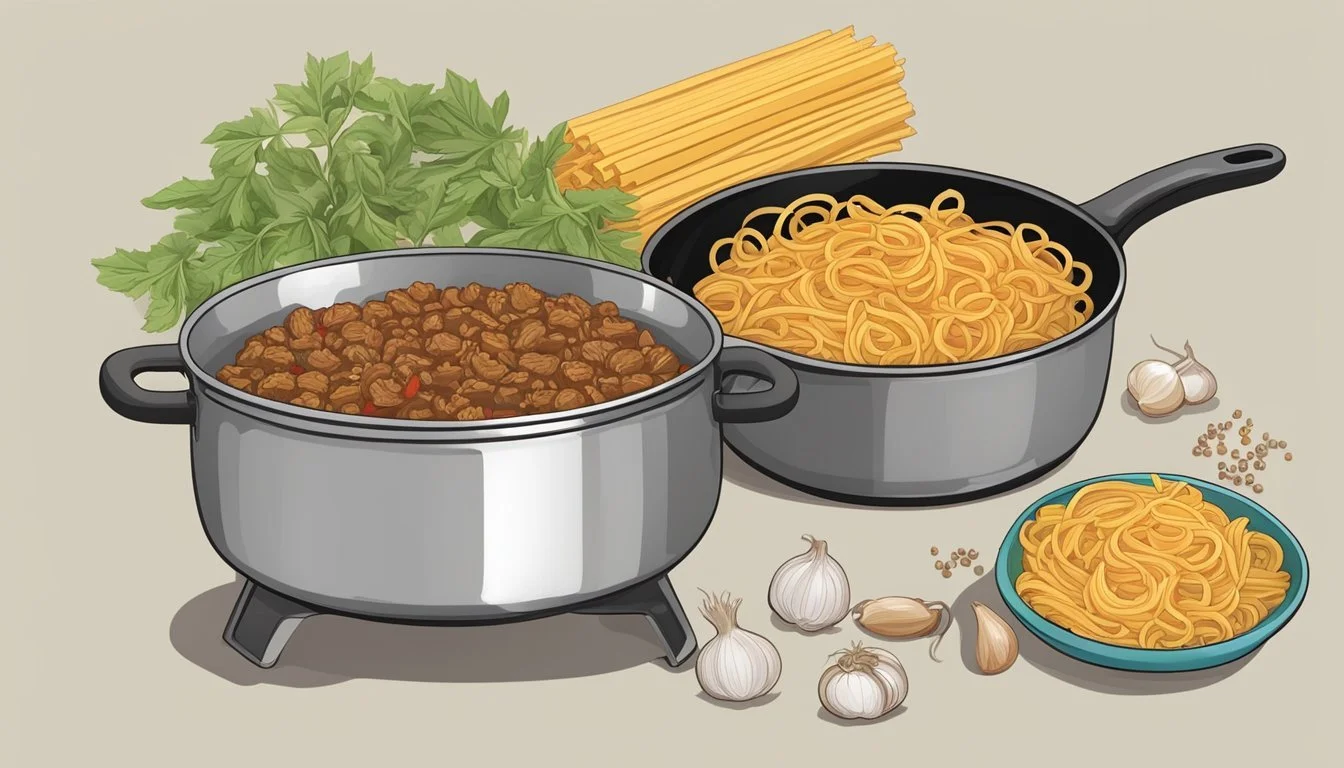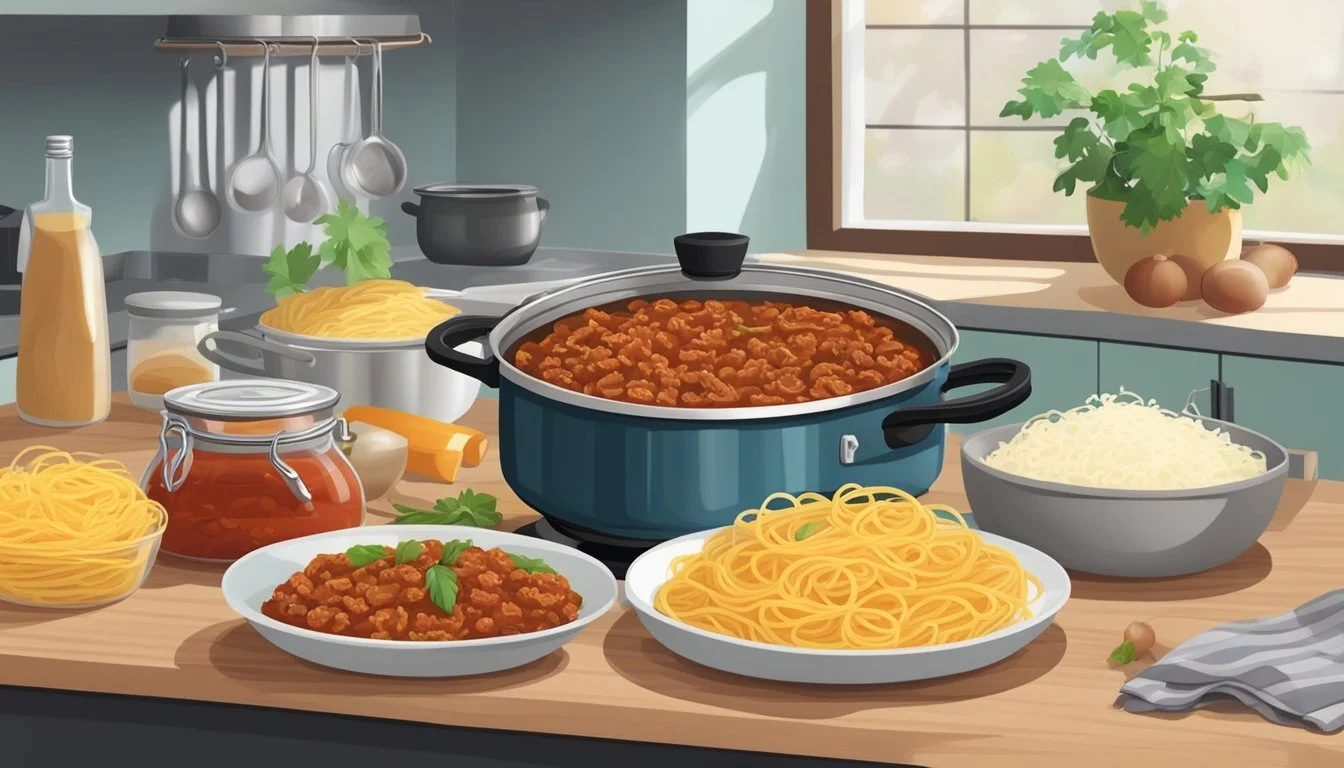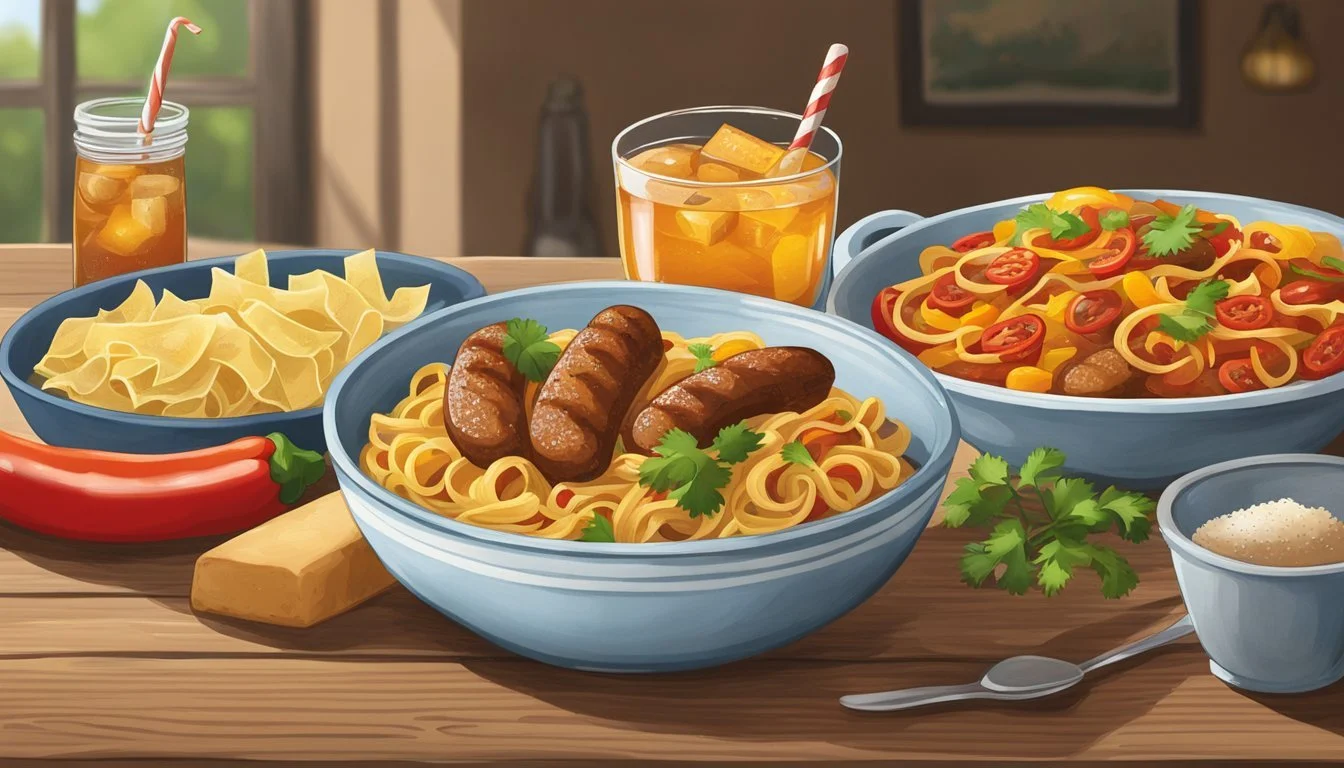How to Create a Texas-Style Pasta Dish
A Step-by-Step Guide
Texas-style pasta (What wine goes well with pasta?) dishes are a hearty twist on traditional Italian recipes, infusing the bold and savory flavors that are characteristic of Texan cuisine. These dishes often incorporate ingredients such as peppers, onions, and a variety of cheeses, creating a comforting and satisfying meal that's perfect for family dinners or social gatherings.
One popular variation is Texas chicken spaghetti, which combines tender chicken with spaghetti noodles in a rich and creamy sauce. The dish is typically seasoned with spices that cater to the Texan palate and can be baked with a cheesy crust to add texture and flavor. It marries the simplicity of pasta (What wine goes well with pasta?) with the robustness of Texan-style cooking, offering a dish that's both easy to make and a crowd-pleaser.
The preparation process involves cooking the spaghetti to al dente perfection and preparing the sauce with a careful balance of ingredients to achieve a depth of taste. Baking the final assembly allows the flavors to meld together and the cheese to melt into a gooey topping, making it a staple comfort food in Texan households and beyond.
Ingredients and Substitutions
Creating a Texas-style pasta dish is all about finding the right balance of hearty proteins, rich cheeses, and bold flavors. Substitutions can be made to suit dietary preferences or availability of ingredients without losing the essence of this comfort food classic.
Choosing Your Pasta
For Texas-style dishes, the pasta chosen typically has a robust structure to hold up against hearty sauces and mix-ins.
Common Pasta Types: Spaghetti, macaroni, and penne are popular choices.
Substitutions: Whole wheat or gluten-free varieties can be used.
Cooking Pasta: Aim for al dente, not overly soft.
Protein Selection
Proteins add substance and richness to the dish.
Common Proteins: Shredded chicken from a rotisserie chicken or ground beef.
Substitutions: Boneless chicken breasts can be cubed and used.
Vegan Option: Omit animal protein or use shredded plant-based substitutes.
Cheeses for Richness
Cheese adds creamy texture and depth to Texas pasta.
Traditional Cheeses: Velveeta, cheddar, and Monterey Jack are staples.
Substitutions: Creamy cheeses such as gouda or a mix of cheddar and cream cheese can be used. Parmesan adds a sharper flavor note.
Vegetables and Aromatics
Vegetables contribute freshness and aromatics build the flavor foundation.
Typical Additions: Onions, garlic, tomatoes, and bell peppers.
Substitutions: Different types of peppers like yellow bell or jalapeños adjust the heat level.
Creating Creamy Sauces
The heart of Texas pasta lies in its sauce, often rich and indulgent.
Base Sauces: Cream of mushroom or chicken soup, sour cream.
Substitutions: A homemade béchamel or a mix of milk and cheese can replace canned soups for a less processed alternative.
Seasoning for Flavor
Seasonings are pivotal for an authentic Texas taste.
Seasoning Substitution Salt — Pepper Freshly ground black pepper offers more bite. Cilantro Fresh or dried can be used. Garlic Powder Minced fresh garlic for more intensity. Chili Powder A mix of cayenne and paprika can replicate the heat and smokiness.
Use these seasonings to taste, being cautious not to overpower the primary ingredients.
Equipment Needed
In order to create a delightful Texas-style pasta dish, one must have the proper equipment on hand. The necessity of specific baking implements, cookware essentials, and storage options not only eases the cooking process but also affects the final taste and presentation of the dish.
Baking Implements
For a Texas-style pasta dish, which is typically baked as a hearty casserole, the cook will need a 9 x 13 inch casserole dish. The dish should be greased with cooking spray to prevent sticking. A casserole allows the flavors to meld together in the oven, usually set at 350 degrees.
Cookware Essentials
The foundational utensil for the initial preparation of the pasta is a large skillet. This is where the spaghetti sauce and meat are cooked to perfection. Having a sturdy skillet ensures even cooking and ample space for browning meat, if the recipe calls for it. Additionally, the chef needs a pot to boil the pasta until al dente, crucial for a firm texture post-baking.
Storage Options
After the Texas-style pasta is prepared and baked, storage becomes important for any leftovers. Utilize freezer-safe containers if planning to freeze the dish, ensuring it remains fresh for later consumption. To store in the fridge, one should opt for air-tight containers to maintain freshness and prevent absorption of other flavors. Proper storage in the refrigerator is critical to extend the meal's edibility for a few days.
Preparation Steps
Creating a Texas-style pasta dish involves several key steps: cooking the pasta to just the right texture, preparing the protein for maximum flavor, layering the ingredients into a casserole, and finishing with a decadent topping of cheese and optional breadcrumbs for texture.
Cooking the Pasta
To begin, they should preheat the oven to 350 degrees Fahrenheit. They need to cook the pasta until it's al dente, which typically takes about 8 to 10 minutes, depending on the type of pasta used. They should then drain the pasta and set it aside. It's important to not overcook the pasta since it will continue to cook in the oven.
Prep time: 10 minutes
Cook time: 8-10 minutes
Handling the Protein
While the pasta is cooking, they should prepare the protein. If they're using chicken, the cook should dice it into bite-sized pieces and brown it in a skillet with a touch of olive oil. If their recipe includes ground beef or another protein, they should cook and crumble it until fully browned and then drain any excess fat.
Cook time: Approximately 7 minutes for chicken
Assembling the Casserole
After greasing a 9 x 13 inch casserole dish, they should layer half of the cooked pasta at the bottom. They then spread half of the prepared protein and any sauce they have chosen over the pasta. This layering ensures an even distribution of flavors throughout the dish.
Adding Toppings and Cheese
Finally, they should add slices of provolone and a healthy amount of shredded mozzarella cheese over the top of the protein layer. If desired, they can sprinkle breadcrumbs for added crunch. The casserole should be baked in the preheated oven until the cheese is bubbly and golden brown, approximately 20-25 minutes.
Baking time: 20-25 minutes
Baking the Dish
Creating a Texas-style pasta dish involves a crucial step: baking. This process melds the flavors together under heat to achieve a harmonious and satisfyingly cheesy result.
Before one begins to bake the dish, the oven must be preheated. An optimal temperature for baking pasta dishes like this is 350 degrees Fahrenheit. During preheating, a casserole dish should be greased to prevent sticking.
Steps for Layering and Baking the Dish:
Arrange layers: Place an initial layer of pasta on the bottom of the dish, ensuring an even spread.
Add Sauce and Meat: Spoon a generous layer of robust, simmered meat sauce over the pasta.
Cheese: Sprinkle with provolone and mozzarella cheese for gooeyness and flavor.
It's important to repeat the layering process until all ingredients are utilized, finishing with a layer of cheese on top.
A Tip on Toppings: For a crunchier topping, Texas-style recipes sometimes include a sprinkle of breadcrumbs mixed with olive oil or shredded cheese.
Baking Time:
Duration: Bake the dish, uncovered, for about 25-30 minutes.
Bubbling Edges: The edges should bubble when it's nearing readiness.
Cheese: The cheese ought to melt thoroughly and start to turn golden brown.
To ensure the pasta is baked to perfection, one should monitor the dish closely as oven times may vary. Post baking, allow the dish to rest before serving to enable the layers to set, ensuring the pasta maintains its structure when served.
Serving Suggestions
When presenting a Texas-style pasta dish, one enhances the dining experience by carefully selecting sides that complement the rich and hearty flavors. Ideally, one should aim for balance, offering lighter accompaniments to offset the robust nature of the pasta.
Complementary Sides
Garlic Bread: A classic pairing, garlic bread offers a crispy texture and savory taste that contrasts well with the pasta's tenderness and complements its taste.
Salads:
Green Salad: A fresh green salad dressed with a light vinaigrette can provide a refreshing counterpoint to the dense and flavorful pasta.
Specific Greens: Opt for greens like arugula, spinach, or romaine to add variety and depth to your salad.
When choosing your sides, bear in mind the unique taste profile of your main dish. Stick to options that enhance and balance, rather than overpower, to create a harmonious meal that can easily become a crowd-pleaser and epitomize southern comfort food.
Storing and Reheating
When it comes to preserving the taste and texture of a Texas-style pasta dish, proper storage and reheating methods are essential. Whether it's storing leftovers in the fridge or freezer, these tips ensure that your baked pasta retains its flavor and quality.
Refrigeration Tips
For optimal freshness, leftover Texas-style pasta should be stored in the refrigerator within two hours of cooking to prevent bacterial growth. It is best kept in a shallow airtight container or tightly sealed with plastic wrap to maintain moisture and prevent contamination. Refrigerated baked pasta can last 3-5 days. To maintain the dish's quality, one should:
Let the pasta cool to room temperature before refrigerating to avoid condensation and sogginess.
Divide large quantities into smaller portions, allowing for more efficient cooling and easier subsequent reheating.
Freezer Storage
Freezing a Texas-style pasta dish is an excellent option for extending its shelf life. Properly stored, frozen baked pasta can last for up to 2 months. To keep flavors intact and prevent freezer burn, one should:
Cool the leftovers completely before freezing.
Use airtight, freezer-safe containers or double-wrap with both plastic wrap and aluminum foil.
Label the containers with the dish's name and the date it was frozen.
When reheating frozen pasta, one does not need to thaw it beforehand; it can go straight from the freezer to the oven or microwave. Adjust cooking times accordingly to ensure the dish is heated all the way through.
Variations and Tips
Creating a Texas-style pasta dish offers room for customization for different dietary needs and spice preferences. One can incorporate classic Tex-Mex flavors, veggies, and even make it a one-pot meal for convenience.
Adjusting Spiciness
Mild: Use bell peppers instead of jalapeños, and opt for a mild chili powder.
Medium: Incorporate a moderate amount of chili powder and add jalapeños to taste.
Hot: Include cayenne pepper and hot sauce in the recipe for an extra kick.
To tailor the spice level specifically to individual preferences, one could serve spicy condiments like chopped jalapeños or hot sauce on the side.
Vegetarian and Vegan Options
Replace Meat: Utilize meat alternatives like seitan, (What wine goes well with seitan?) tempeh, or plant-based ground meat substitutes.
Cheese: Opt for vegan cheese or nutritional yeast to mimic the cheesy texture and taste.
For those who wish to maintain the protein content, incorporating beans such as black or pinto beans can offer both taste and nutrition while staying true to Tex-Mex flavors.
Gluten-Free Alternatives
Pasta: Select gluten-free pasta options, such as those made from rice, corn, or quinoa.
Thickeners: Use cornstarch or a gluten-free flour blend instead of regular flour for roux or sauces.
Careful reading of labels is critical when selecting gluten-free ingredients to avoid cross-contamination and ensure that the dishes are suitable for those with celiac disease or gluten intolerance.









